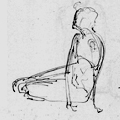| | WOODLAND HILLS WORKSHOPS (Near Salem, UT) Round out your summer with art workshops for children, teens and adults in Kirk's studio. Click HERE for a complete schedule and to register for classes. |
| | FREE MONTHLY ART LESSONS VIA BROADCAST AND MASTER CLASS Kirk hosts free master classes at his home studio: 1130 Eagle Nest Dr, Woodland Hills, UT. The master class begins with a 30 minute instructional presentation on an art related topic, followed by a group critique or question and answer session. Bring something you're working on and ask for feedback, or just come and listen. Master classes are tentatively scheduled for the following times (please check this page for schedule changes): |
 | FIGURE DRAWING SESSIONS Kirk facilitates a monthly figure drawing session. For details including dates and locations, email Kirk. |
| | LESSON 1.A: SHADING Values (or lights and darks) are the fundamental basis of painting and drawing. This video demonstrates which tools to use and how to create a smooth transition from the lightest lights to the darkest darks. Shading techniques are demonstrated. Recommended for any age or skill level. The more advanced the student, the more polished the finished product should be. |
| | LESSON 1.B: CHICKEN SCRATCH SKETCHES One of the best habits an art student can develop is the habit of sketching. This demonstration explains a good way to get started developing this habit. Recommended for any age or skill level. |
| | LESSON 1.C: THREE COLOR PAINTING Painting can be intimidating. This simple activity will help overcome those initial fears. This demonstrations explains how to prepare a panel and introduces a simple way to start with color. Recommended for any age or skill level. |
| | LESSON 1.D: FINISH THE FACE This is an accuracy exercise. Half of the face is provided and the other half needs to be finished. Principles and tricks of accuracy are demonstrated. Recommended for any age or skill level. |
| | LESSON 1.E: BASIC MEMORY DRAWING This exercise serves to develop your ability to draw from imagination and memory. Simple principles of capturing and retaining information are demonstrated. Recommended for any age or skill level. |
| | LESSON 2.H: MONOCHROMATIC COLOR How to use color in artwork can be a daunting challenge to navigate. This is the first in a series of color theory exercises aimed at giving you confidence when using color. We'll begin with the most simple building block, monochromatic color, and add more options with each new exercise. Before doing this exercise, I recommend you do exercises 1.A and 1.C. |
| | LESSON 2.I: TRIAD COLOR How to use color in artwork can be a daunting challenge to navigate. This is the second in a series of color theory exercises aimed at giving you confidence when using color. Before doing this exercise, I recommend you do exercises 1.A, 1.C, and 2.H. |
| | LESSON 2.J: ANALOGOUS COLOR How to use color in artwork can be a daunting challenge to navigate. This is the third in a series of color theory exercises aimed at giving you confidence when using color. Before doing this exercise, I recommend you do exercises 1.A, 1.C, and 2.H. |
| | LESSON 2.K: COMPLIMENTARY COLOR How to use color in artwork can be a daunting challenge to navigate. This continues a series of color theory exercises aimed at giving you confidence when using color. Before doing this exercise, I recommend you do exercises 1.A, 1.C, and 2.H. |
| | LESSON 2.L: NEUTRAL COLOR How to use color in artwork can be a daunting challenge to navigate. This continues a series of color theory exercises aimed at giving you confidence when using color. Before doing this exercise, I recommend you do exercises 1.A, 1.C, and 2.H. |
| | LESSON 2.M: ACCENTED NEUTRAL COLOR How to use color in artwork can be a daunting challenge to navigate. This continues a series of color theory exercises aimed at giving you confidence when using color. Before doing this exercise, I recommend you do exercises 1.A, 1.C, and 2.H. |
| | LESSON 2.N: MUTED TRIAD COLOR How to use color in artwork can be a daunting challenge to navigate. This continues a series of color theory exercises aimed at giving you confidence when using color. Before doing this exercise, I recommend you do exercises 1.A, 1.C, and 2.H. |
| | LESSON 2.O: MOTHER COLOR How to use color in artwork can be a daunting challenge to navigate. This continues a series of color theory exercises aimed at giving you confidence when using color. Before doing this exercise, I recommend you do exercises 1.A, 1.C, and 2.H. |
| | LESSON 6.Q: PAINT A SELF PORTRAIT In this demonstration, we will paint a self portrait using a semi-direct painting approach. We will paint directly into glazes with each sitting, focusing on the use of triangles of color, temperature shifts, edges, contours, and lighting. |
